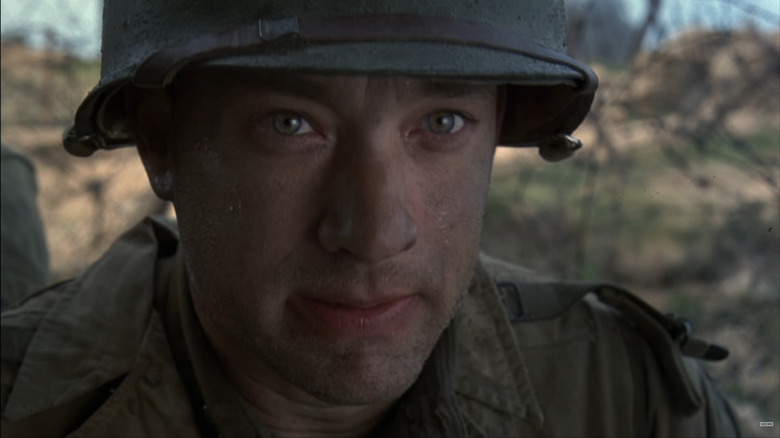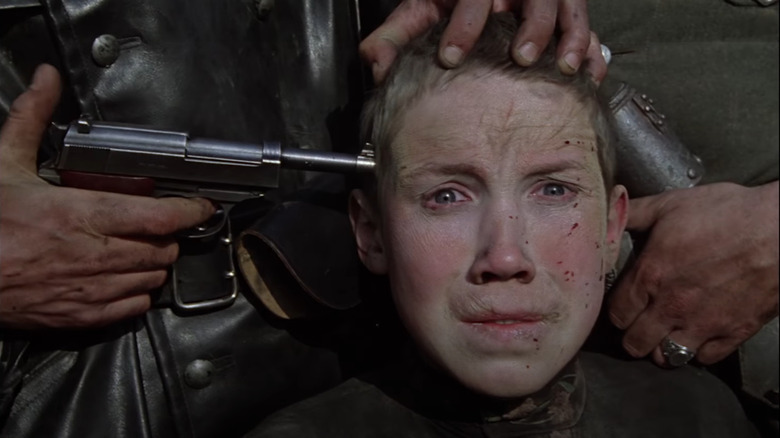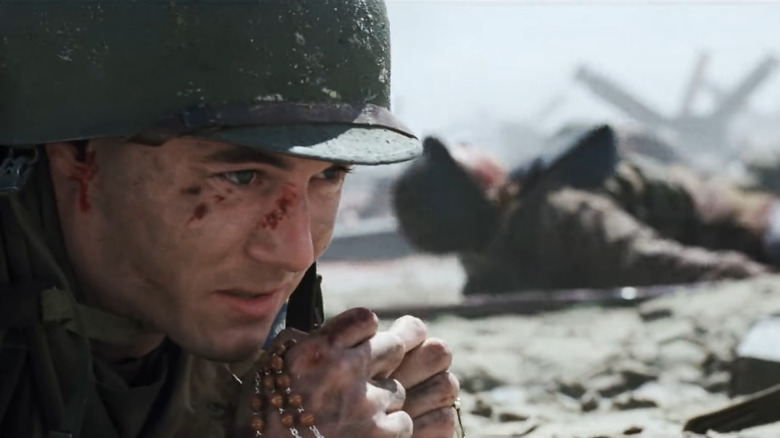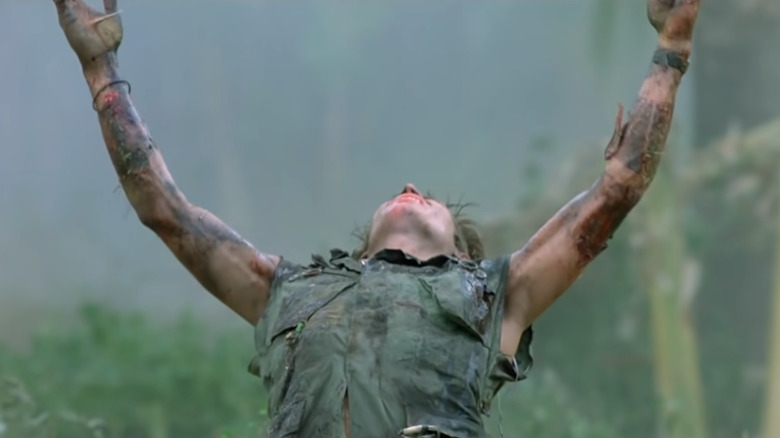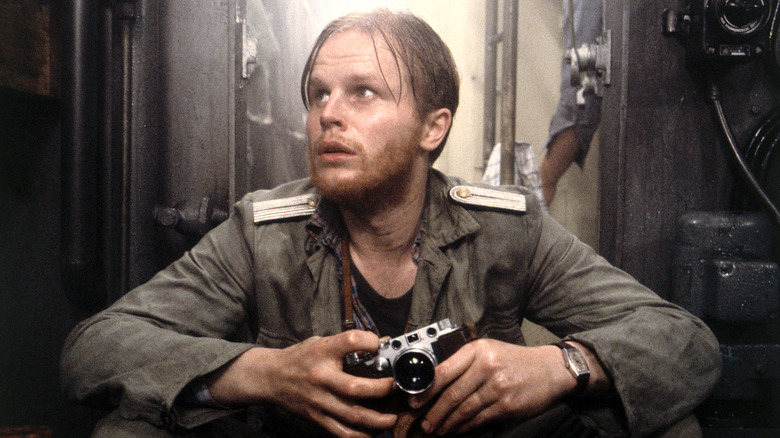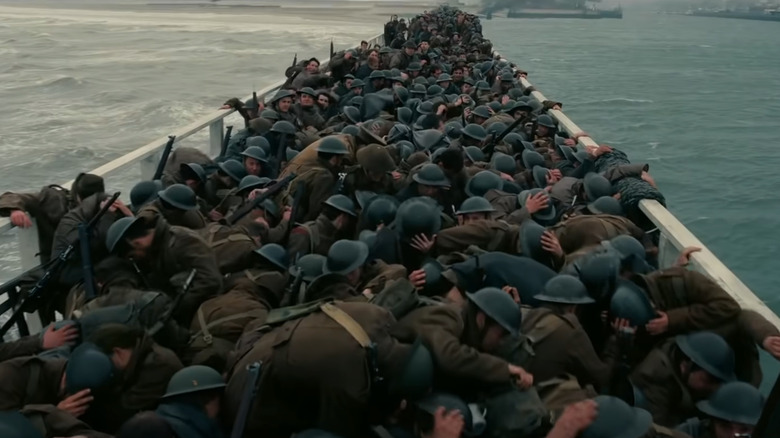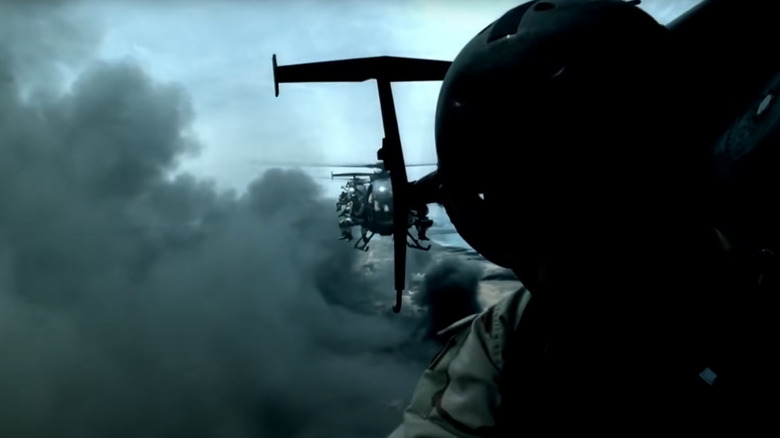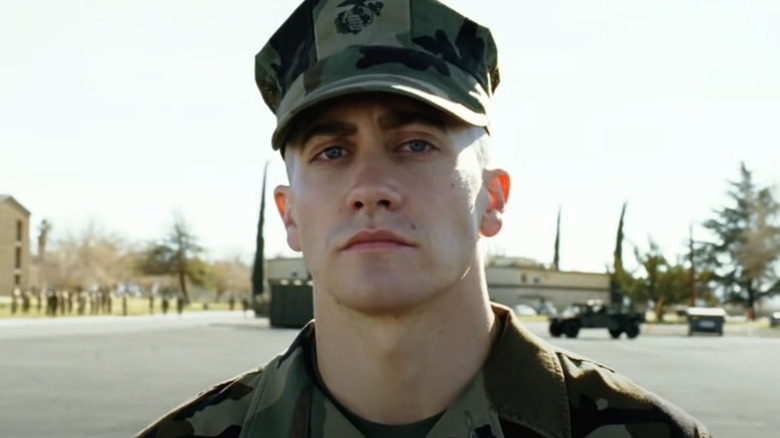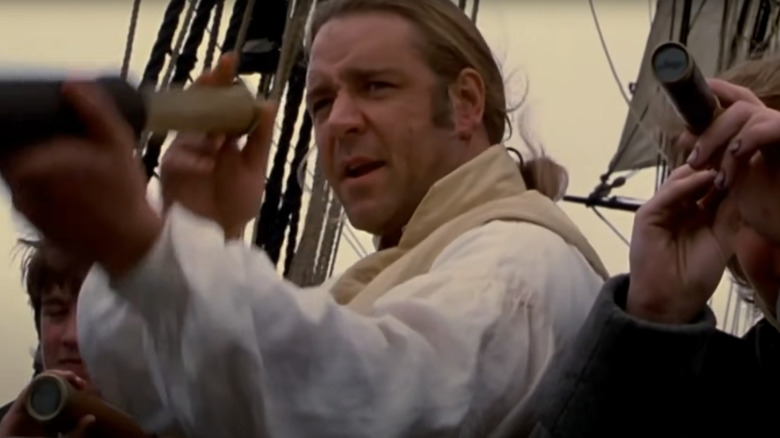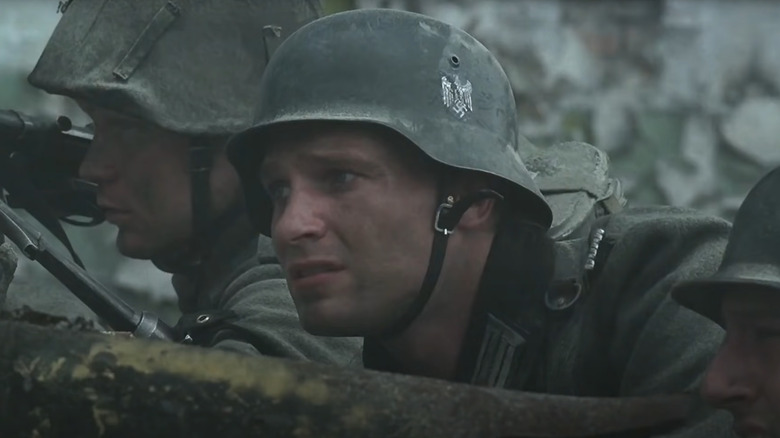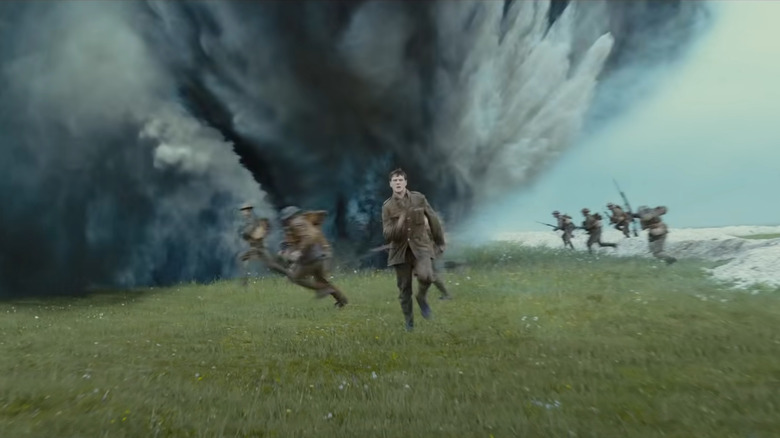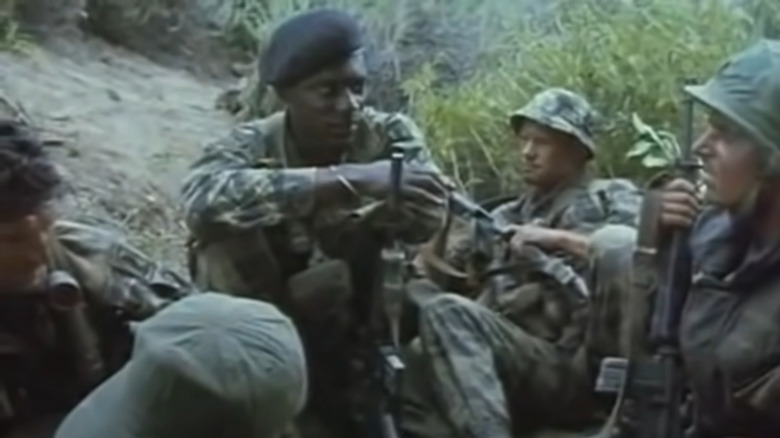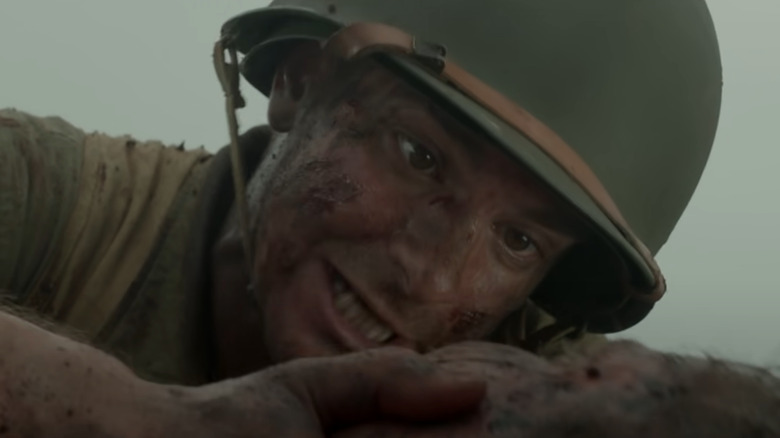Hands-Down The Most Accurate War Movies Ever Made
No matter how realistic a movie seems, film adds a layer of fiction. Even documentaries can't be totally trusted, as they use editing and music to dramatize, simplify, and frame the facts. And films usually have goals other than a realistic depiction of actual events. They seek to be dramatic (or funny), and they're often just as concerned with making us care for the characters as they are with depicting a situation with total accuracy. This is often exacerbated when the film in question is set during combat. War is something that the vast majority of us have never experienced — less than half a percent of the population has served in a branch of the military (via FiveThirtyEight). That means that most war movies can get by with a realistic "feel," meaning that as long as it feels plausible to the audience, it works.
Not all war movies actually achieve a high level of accuracy, but some were made by teams that actually did their research, and these films get very high marks for depicting war in a very accurate and realistic way. While no film will ever be able to convey the true horrors of war, some films at least get the details right, including the tactics, conditions, equipment, and psychological impact on the men and women on the front lines. Here are the most accurate war movies ever made.
Come and See: Both real and surreal
Elem Klimov's 1985 film was made in the waning years of the Soviet Union. Vanity Fair reports that he had to fight for years to get the film made in the face of government censorship. Klimov, who experienced the siege of Stalingrad personally, worked a lot of his own experience into the film, and it paid off: "Come and See" is often called one of the most accurate war movies ever made.
The story is simple: In Nazi-occupied Belarus in 1943, a young boy named Flyora decides to join the resistance and fight the Nazis, experiencing a series of horrifying atrocities that culminate in one of the most disturbing endings in film history. Its reputation for accuracy comes despite some very deliberately surreal compositions — it feels like a nightmare, not a documentary. And yet, as noted by Slant Magazine, that's what makes "Come and See" so realistic. As cinematographer Roger Deakins notes, the film's revolutionary Steadicam work puts us right in the midst of war. Add to this the fact that the production used live bullets instead of blanks in order to get truly terrified reactions from the actors, shot in natural light for a realistic look, and adjusted the sound design to match the physical state of the actors (via Russia Beyond), and you have a film that feels more real than any other war movie.
Saving Private Ryan: The best D-Day of all
Steven Spielberg's 1998 film "Saving Private Ryan" is a modern classic. As noted by TIME, the story is based on real-life events, including the simultaneous deaths of the five Sullivan brothers on board the USS Juneau in 1942 and the army's decision to send paratrooper Fritz Niland home after his brothers died in combat. While the bulk of the story is fiction and takes some liberties with the lived experience of American soldiers in Europe during World War II, the film is regarded as a classic of war realism because of its epic opening scene depicting Operation Overlord and the landings on Omaha Beach on D-Day.
As noted by Colonel Kevin Farrell, former Chief of Military History at the U.S. Military Academy (per The National WWII Museum), the film's D-Day sequence perfectly captures "the sense of chaos and confusion" experienced in combat. Where some war movies make combat seem very organized, "Saving Private Ryan" depicts the huge invasion of Europe as a violent, bloody mess. Soldiers don't know where to go or where they are. Units get scattered. Maps prove useless.
History vs. Hollywood reports that the sound design of the film enhanced its accuracy because every weapon used on-screen has an authentic sound effect, and the scene uses actual landing craft and other 1940s equipment. And author Steven J. Rubin notes in his book "Combat Films" that "Saving Private Ryan" also uses a lot of accurate military jargon without bothering to explain it, which gives the opening scene another level of realism.
Platoon: The soldier's experience
Director Oliver Stone actually served in Vietnam. As reported by the Department of Defense, Stone enlisted and served in the Army from 1967 to 1968 and received a Bronze Star for valor. So it's not too surprising that his film based on his experiences in Vietnam, "Platoon," is regarded as one of the most accurate war movies ever made.
As noted by TIME, the film depicts how American forces misunderstood the terrain they were fighting in and how the thick jungle and difficult terrain almost completely "negated U.S. technological superiority," reducing combat to endless guerrilla actions. According to Task & Purpose, retired marine and long-time film industry technical adviser James Dever considered the combat scenes in "Platoon" to be accurate and the depictions of the soldiers as filthy and desperate to be incredibly realistic.
And that's where "Platoon" excels. It's not as obvious today, but as noted by author Steven J. Rubin notes in his book "Combat Films," in 1987, "Platoon" was the first film to accurately depict how U.S. soldiers looked, thought, and behaved in Vietnam. It humanized soldiers who had either been demonized as monsters or lionized as perfect heroes, and the result is a movie that depicts the Vietnam War more accurately than most others.
Das Boot: Realistic pressure
"Das Boot" is a brilliant film. Released in 1981, it was a worldwide hit and remains a favorite among fans of war movies to this day. And the reason it's so beloved is simple: It is, hand down, the most accurate film depiction of what it was like to serve on a German U-Boat in World War II.
According to War History Online, one reason for this accuracy was the presence of two consultants who actually served on German U-Boats during the war: Heinrich Lehmann-Willenbrock and Hans-Joachim Krug. Add to that director Wolfgang Petersen's attention to detail, building a near-perfect replica of real-life submarine U-96, and you have all the makings of a realistic war movie.
More than that, though, the film shows what life serving on a U-Boat was really like: absolutely miserable. According to Far Out Magazine, "Das Boot" was always intended to show how terrible life on board a U-Boat was — and every frame of it is essentially accurate, even if you can't believe men actually lived under such cramped, filthy conditions. The combat scenes are also delivered in what the Chicago Tribune called a "hyper-real" style, resulting in a film that gets as close to real-life on a U-Boat as any of us would probably want.
Dunkirk: A nonlinear triumph
Christopher Nolan's "Dunkirk" is a strange war movie in a lot of ways. As noted by historian Michael Korda in GQ, the film has no main character and no real narrative. Indeed, it's a big-picture story about the miraculous survival and rescue of 340,000 British, French, and Belgian troops from the French port after German forces had trapped them there.
Nolan doesn't offer the usual war movie scenes of politicians and generals gravely explaining the historical details — in fact, no one even mentions the fact that it's the German army and air force closing in on the soldiers on the beach. Instead, he focuses on capturing the sense of chaos and terror experienced by the troops, especially as every attempt to escape doom seems to inevitably fail. According to former Marine Tan Vega (via Coffee or Die), Nolan definitely succeeds in "recreating the plight of tending to your fellow soldier while being under constant threat of bombardment."
As reported by PopMatters, the film's aerial combat has also been praised as exceptionally accurate. And as noted by Hypebeast, despite the fact that it's largely impossible to find equipment and uniforms dating from the period, costume designer Jeffery Kurland did exceptional research to ensure that every bit of the film is historically accurate in terms of look and material.
Black Hawk Down: Accurate combat, inaccurate history
Ridley Scott's 2001 film "Black Hawk Down" depicts the events of the Battle of Mogadishu. As explained by Smithsonian Magazine, in 1993, U.S. Army Rangers and Delta Forces were dispatched to the city to capture or kill Somali warlord Mohamed Farrah Aidid. The mission went wrong in several ways, two Black Hawk helicopters crashed, and a large number of American soldiers were trapped. An 18-hour gunfight ensued.
Although the film has received significant criticism for a simplified version of history — as noted by Cinemablend, it ignores the vital roles played by Malaysian and Pakistani forces in favor of a slightly racist white-vs-black narrative — its depiction of the battle has been praised. In his book "Combat Films," author Steven J. Rubin calls the film "amazingly realistic." Insider also quotes a retired Delta Force operator as saying, "What makes it a good movie and distinguishes it from other war movies is the violence of action. The producers and directors did a really good job at capturing that."
As noted by the Lehigh University's Reel History Project, one reason the film does such a great job depicting the battle is how well-documented the battle was. Unlike military operations in the distant past, the filmmakers had plenty of detailed reports and firsthand experiences to refer to. The U.S. military was very cooperative as well and helped train the actors, who in some cases got to meet and interact with the real-life soldiers they were portraying.
Jarhead: Welcome to the suck
Based on former U.S. Marine Anthony Swofford's autobiographical book, "Jarhead" is a different kind of war movie that captured a different kind of realism. As noted by Screen Rant, what this film gets so accurate about combat is how dreadfully, soul-crushingly boring it can be. Instead of a war movie filled with breathless action and perfectly-choreographed combat scenes, the film offers a glimpse of the tight bonds formed between the marines and the ways they deal with the loneliness and anxiety of war — not to mention the frustration of receiving orders that don't always seem to make much sense. The Tufts Daily notes that the lack of combat sequences in the film is crucial because it allows the narrative to focus on the "amazingly realistic" depiction of the day-to-day lives of marines.
As noted by the Los Angeles Times, the way war is fought changed shortly after "Jarhead" was released, which makes it seem less realistic to modern audiences — or modern marines. But as a snapshot of a time and place in America's military, it's a classic.
Master and Commander: Old school accuracy
As noted by The New York Times, the film "Master and Commander: The Far Side of the World" had an enormous advantage when it comes to war movie accuracy: the source material. Author Patrick O'Brian was well-known for infusing his novels with incredibly detailed research on what life and sea combat was actually like during the Napoleonic era. Reading the books is almost like taking a crash course in early 19th-century seamanship.
The translates to the film, which features incredibly accurate depictions of the ships and their operation, the interactions of the crew and officers, and the chaos and terror of a sea battle, with cannons roaring and men literally swinging from ship to ship with pistols tucked in their pants. As noted by War History Online, the dialogue is extremely accurate for the time and situation, as is the fact that children served in the British Navy — and could even be officers. Even the impact of 19th-century bullets and cannonballs on wooden ships is depicted with extraordinary realism.
This realism extends to the sounds of the film. Author David Lewis Yewdall notes in his book "Practical Art of Motion Picture Sound" that sound designer Richard King went to great extremes to record authentic cannons and gunpowder ignitions in order to create a soundscape for the film that's as close to reality as possible.
Stalingrad 1993: Small-scale accuracy
The German-language film "Stalingrad" was released in 1993. As noted by Weapons and Warfare, the film follows a single squad of German soldiers from their arrival at the Eastern Front as the German army surrounds and partially captures the city of Stalingrad in September 1942. This proved to be the high-water mark of the German advance — the 6th Army was soon encircled and besieged in the city, and Hitler's refusal to order a breakout and rescue doomed his soldiers to a slow death as the winter and starvation closed in.
Not only are the uniforms, equipment, and weapons all rendered accurately and the battle sequences "virtuosic" (per The New York Times), but what makes the film so accurate and realistic is its focus on the experience of a small group of soldiers. The National Interest notes that the film doesn't attempt to offer a high-level overview of the war or even Germany's invasion of Russia — it is solely focused on the misery and terror experienced by the German soldiers in the midst of the fighting. The horrors of war are shown with unflinching realism, from the terrified men dying in agony to the incredible callousness of the commanders who doomed them to certain death.
From tanks dealing brutal death to infantry to desperate hand-to-hand combat in freezing conditions, "Stalingrad" shows the suffering and pointless slaughter of warfare as realistically as can be managed on the screen.
1917: Unbroken attention to detail
As reported by The Guardian, Same Mendes' 2019 film was inspired in part by a true story involving his own grandfather, Alfred H. Mendes. The film is edited to offer the illusion of a single, two-hour, unbroken shot as two young British soldiers head into an eerily abandoned No Man's Land and into German-held territory in order to carry a vital message to British commanders.
Mendes employed several military advisors and historians to ensure that every detail — from the shape of the soldiers' helmets to weapon discipline to the way soldiers constantly monitored their boots and feet — was accurate. And this work paid off: The Kansas City Star reports that experts from the World War I museum praised the film's accuracy, noting that small details like an insignia pinned to the back of an officer's collar and the differences between German and British trenches were spot-on.
According to The National Interest, the film's incredible historical accuracy can be verified by comparing it to Peter Jackson's "They Shall Not Grow Old," a documentary compiled from the restored film from World War I. In other words, "1917" is so accurate it holds up when compared to actual footage from the war it's depicting.
84 Charlie MoPic: The forgotten classic
"84 Charlie MoPic" was directed by Patrick Duncan, a Vietnam veteran who served with the 173rd Airborne Brigade. That firsthand experience might explain why this low-budget and somewhat forgotten film is regarded as one of the most realistic depictions of the Vietnam War ever put on film. As noted by author Robert Niemi in his book "100 Great War Movies," the film depicts a realistic unit from the war and is accurate in terms of the equipment and weaponry shown. Impressively, it was named as one of the most historically accurate war movies of all time by veteran and author Gordon L. Rottman.
According to Roger Ebert, the film uses a "found footage" style to bring the viewer as close to the war experience as possible. Notably, an army cameraman is embedded with a small unit on patrol in order to capture footage for training purposes. As noted by Slant Magazine, this captures one of the realities of modern warfare that's often ignored by more theatrical war movies: the stretches of surreal calm in-between terrifying violence that results in a "warped sense of temporality within combat situations." The film also depicts combat from the era accurately, showing combat as confusing — the enemy hidden and the direction of fire impossible to know.
Hacksaw Ridge: Accurate pacifism
As noted by Roger Ebert, "Hacksaw Ridge" is based on the true story of Desmond T. Doss, who was awarded the Medal of Honor in World War II despite never firing a shot. Despite his commitment to pacifism, Doss served his country and rescued 75 of his fellow soldiers during the Battle of Okinawa.
Although the combat scenes were filmed on a cow pasture in Australia (and The Guardian notes the set created for the film doesn't match up very closely with the actual Hacksaw Ridge), the film manages to depict the carnage of the battle and Doss' incredible bravery extremely accurately. According to Deadline, the movie's recreation of the battle was praised by Don Kirchner, whose father George was actually at the battle. Kirchner said that the "movie depicted it just as my father had described the battle."
Even more importantly, as TIME reports, the film got the facts around Doss and his experiences right. Doss was the victim of harassment from his fellow soldiers and his commanding officers due to this pacifism, and the film even takes lines of Doss' dialog directly from things he actually said. As incredible as the story of Desmond T. Doss seems, the film shows it pretty much as it actually happened.
